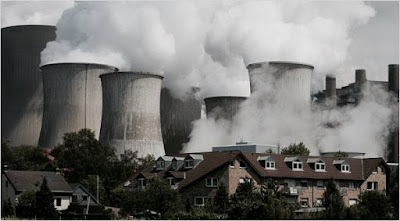Nuclear energy is necessary to fight climate change
Nuclear energy is necessary to fight climate change and decrease fossil fuel use. Wind and solar are often distributed energy sources which are always intermittent and variable. Nuclear, however, is continuously available and represents a much more concentrated source of energy than renewables, with a much higher production capacity. Both nuclear and renewable energy's contribution to energy production on the planet must increase to a combined energy production level which is a little more than what coal alone currently provides.
In order to significantly cut down on the share of fossil fuels in the world energy mix, at least double the production of that which is illustrated in the chart above is needed by 2035. (A total of 40% of the world's energy mix for renewable and nuclear energies combined is needed to reach significant GHG targets. Only 20+% of renewable and nuclear combined is projected in 20 years - by 2035).
In order for the entire planet to achieve at least 25% greenhouse gas (GHG) reduction by 2025 compared to 2015 levels (a reasonable, yet challenging, GHG reduction goal for the planet), nuclear energy is going to have to augment truly clean, renewable energy in the effort to dramatically reduce fossil fuel use. Once it’s at the operational stage, carbon dioxide emissions from a nuclear reactor and the power plant’s site are minimal. Other than reduction of emissions, nuclear offers, by far, the most energy dense resource available.
Fossil fuels are more energy dense than renewable energy sources, but 1 kg of coal can only keep a light bulb lit for a few days, while the same quantity of a nuclear energy source will keep the same bulb lit for well over 100 years. Nuclear does this without any CO2, or most other GHG, emissions from the nuclear plant.
Current reactors, 1st and 2nd generation plants, rely on water and uranium. Therefore, these nuclear plants still deplete water supplies, create nuclear waste, use a fuel source that can be enriched to convert the material into a bomb, and represent a source of potential danger, as in the Fukushima disaster (although this risk is dramatically minimized in a 3rd generation plant).
A safer, cheaper, and still energy abundant and emissions-free design that uses relatively benign energy sources and relatively much less water than previous designs and operational plants, is being envisioned in 4th generation nuclear, and is currently available in 3rd generation designs.
Using a small fraction of the water as previous designs, the 4th generation nuclear plant designs are safe, cost-effective, environmentally-friendly and still offer tremendous potential for energy production. Molten salt reactors using depleted uranium, nuclear waste from other plants, or thorium, are being designed as 4th generation nuclear plants. 4th generation designs (and many 3rd generation plants, both planned and operational) are autonomous, smart plants that are even being designed to run on different fuel sources.
Thorium, instead of uranium, is being looked at as a fuel source, as it is abundant, much less radioactive than uranium, and also creates by-products from burning the fuel source, that can just be used again in the reactor. Thorium reactors are being designed with low up-front capital costs, and little manpower is needed to run and maintain 4th generation plants, due to the advanced computer technology set to be deployed in the plants.
Thorium, and depleted uranium, have a very low chance of being developed into a nuclear weapons, produce less radioactive waste, are abundant fuel sources, and are safer, cheaper and cleaner.
Thorium, in particular, is being looked at by developing nations like China and India because of the relatively low cost, increased safety, abundance of the material, and tremendous energy potential of this energy source. The U.S. has huge amounts of thorium, in places like Kentucky and Idaho, and there are large quantities in countries like India, Australia and Brazil.
The U.S., Europe and even some of the aforementioned developing countries also have large stockpiles of depleted uranium, with more being produced every day, which would work in many of the 4th generation designs. 3rd generation nuclear plants are already operating, and some 4th generation plants are projected to be developed and ready for operation by 2025. 4th generation nuclear promises to produce abundant, low-cost energy safely, and with little environmental impact.


